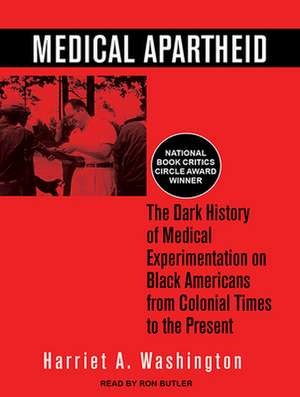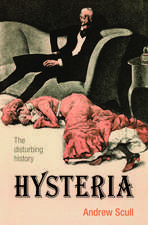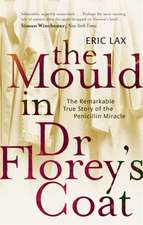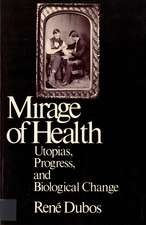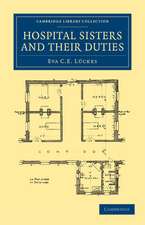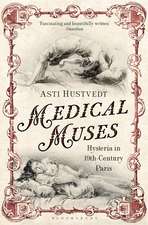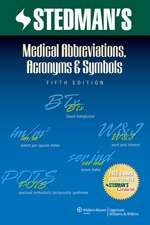Medical Apartheid: The Dark History of Medical Experimentation on Black Americans from Colonial Times to the Present
Ron Butler Autor Harriet A. Washingtonen Limba Engleză CD-Audio – 7 mar 2016
Preț: 283.97 lei
Preț vechi: 298.91 lei
-5% Nou
Puncte Express: 426
Preț estimativ în valută:
47.95€ • 51.27$ • 39.98£
47.95€ • 51.27$ • 39.98£
Indisponibil temporar
Doresc să fiu notificat când acest titlu va fi disponibil:
Se trimite...
Preluare comenzi: 021 569.72.76
Specificații
ISBN-13: 9781515902966
ISBN-10: 151590296X
Dimensiuni: 163 x 140 x 41 mm
Greutate: 0.32 kg
Ediția:CD
Editura: Tantor Audio
ISBN-10: 151590296X
Dimensiuni: 163 x 140 x 41 mm
Greutate: 0.32 kg
Ediția:CD
Editura: Tantor Audio
Notă biografică
HARRIET A. WASHINGTON has been a fellow in ethics at the Harvard Medical School, a fellow at the Harvard School of Public Health, and a senior research scholar at the National Center for Bioethics at Tuskegee University. As a journalist and editor, she has worked for USA Today and several other publications, been a Knight Fellow at Stanford University and has written for such academic forums as the Harvard Public Health Review and The New England Journal of Medicine. She is the recipient of several prestigious awards for her work. Washington lives in New York City.
Extras
CHAPTER 1
SOUTHERN DISCOMFORT
Medical Exploitation on the Plantation
Celia’s child, about four months old, died last Saturday the 12th. This is two negroes and three horses I have lost this year. –DAVID GAVIN, 1855
Frederick Gardiner, a peripatetic Mormon physician, left among his travel memoirs an impression of the nineteenth–century slave markets of Washington, D.C.:
There are a great number of Negroes, nearly all of whom are Slaves. And on different Streets are large halls occupied as Marts or stores, for the sale or purchase of Slaves. . . While I have been looking at one of these places on Gravier Street, Two Gentlemen have arrived, one of whom I have Seen in the Saloon, he is a young Planter and come to purchase a girl to take care of his children, or whatever duties he may think proper to impose upon her. The other person is a Doctor whom he has brought with him for the purpose of examining her. They pass along the front of the row in company with the agent or Salesman. As they move forward One is called upon to stand up, then another while a passive examination is made. Then finally he discovers a bright mulatto, who appears about 16 years of age and is quite good looking. She is ushered into a private room where she is stripped to a nude condition and a careful examination is made of all parts of the body by the Dr. and is pronounced by him to be sound. The money is then paid and she is transferred to her new owner…I have heard that the Masters beat and scourge them most cruelly. But I have not seen anything of the kind, nor do I believe that it occurs very often. For the southern people as a class are Noble minded kind hearted people, as can be found in any country…And moreover it would be against their own interests, to brutally treat their Slaves. As no planter desired to have sick negroes on his hands. According to my judgment so far as my experience extends, I believe that the Negroes as a class, are far more humanely treated and taken care of, Than are the laboring classes of European countries (1).
Enslavement could not have existed and certainly could not have persisted without medical science. However, physicians were also dependent upon slavery, both for economic security and for the enslaved “clinical material” that fed the American medical research and medical training that bolstered physicians’ professional advancement. Gardiner’s vignette suggests the integral role of medicine in enslavement and repeats a key belief—that slave owners and physicians shared an interest in preserving the slave’s health, “as no planter desired to have sick negroes on his hands.” But although medicine was essential to enslavement, the apparent solicitude for the health of slaves was not all it seemed. Rather, the medical interests of the slave were often diametrically opposed to the interests of his owner and of American physicians. From the first, antagonism reigned between African Americans and their physicians.
Between the seventeenth–century advent of African settlers to North America and the end of the nineteenth century, the slave and the physician shared an unrecognizably primitive medical world. The “germ theory” that revealed the microbial nature of much disease and led to the first grand waves of disease cures was still well in the future: The existence of pathogens (2) such as bacteria, viruses, and fungi was unsuspected. Almost no effective treatments existed for prevalent diseases until the eighteenth century. Until the late 1830s, the lack of effective anesthesia made the few common surgical procedures horribly painful and all others impossible.
Between the seventeenth and nineteenth centuries, medicine in the United States reflected a narrowly limited understanding of disease and a rather cursory training of medical practitioners. Public–health institutions were few, feeble, and ephemeral, rising momentarily with epidemics of yellow fever or smallpox and subsiding from neglect after the crisis resolved. Even the simplest public–health measures—hand washing and antiseptic techniques, clean water, sound, pathogen–free housing, an untainted food supply, sewage management, and quantitative disease reporting were all in the future. Because there were only a few effective disease therapies and no antibiotics, epidemics of yellow fever, malaria, tuberculosis, and other infectious diseases frequently raged unchecked. In the early 1700s, this mirrored the situation in England and the rest of Europe, but medicine on the Continent began to undergo modernizing changes, although these were very slow to cross the Atlantic. Europe began to embrace public–health measures and medical advances such as widespread vaccination, scientific medical education, and the rise of the hospital, but American progress lagged behind, especially in the insular South.
The point of this chapter’s unflattering précis of nascent American medicine is not to castigate it for its primitivism, but to put blacks’ historical aversion to medical care into context, for most antebellum blacks were subjected to southern medicine.
The South was a particularly unhealthy region and was home to 90 percent of American blacks, the majority of whom were enslaved until 1865. The first blacks arrived in the colonies in 1619, and by 1700 there were only about 20,000 blacks. But as the slave trade flourished, 20,000 more blacks arrived each year. Although 30 percent of transported slaves died in the nightmare of the Middle Passage, there were 550,000 chattel slaves in the United States by 1776, when blacks constituted 20 percent of the U.S. population. By 1807, slave importation was legally prohibited throughout the country, and by 1860, the nation’s four million enslaved blacks had a value equivalent to four billion dollars today. In some states, the black population completely comprised slaves: Alabama, for example, forbade the presence of free blacks.
The South was the nadir of the American medical experience, visited by a deadly triple confluence—the pathogens of North America, Europe, and Africa. This unholy trinity yielded a bewildering array of unfamiliar infectious diseases, such as hookworm, types of malaria, and yellow fever, incubated by a subtropical climate that was hospitable year–round to pathogens that could not thrive in the colder North. Even familiar European illnesses flared anew in strangely virulent forms, abetted by the hot, marshy climate, poor sanitation, and a public–health vacuum. Although the South harbored a highly visible affluent class, the region’s relative poverty led to a dearth of medical care and a host of unrecognized nutritional–deficiency diseases. So did enslavement.
A dramatically misunderstood set of disease etiologies led to the adoption of heroic remedies calculated to kill or cure. Through the eighteenth century, Western medicine was not only misinformed but dangerously so. Caustic medicines of the period often contained metabolic poisons such as arsenic, or calomel, (3) a compound of mercury and chlorine that was used as a purgative. Many other remedies contained highly toxic substances such as mercury and addictive Schedule II narcotics, including the opiates laudanum, (4) opium, and morphine, as well as cocaine derivatives. These medicines addicted, sickened, or killed outright; they also could trigger chemical pneumonitis, or progressive lung injury, if inhaled during a bout of iatrogenic, or physician–triggered, vomiting. No studies seem to have been done on this point, but such lung injuries may have helped to account for slaves’ higher death rate from respiratory disease.
Induced vomiting was an everyday event because the common denominator of medical techniques in this period was the violent release of bodily fluids. Copious bleeding, blistering, and the induction of violent diarrhea were standard therapies. Harsh laxatives or “draughts” such as calomel or jalap (5) produced copious diarrhea, which leached nutrients, water, and electrolytes from the body. They also invited painful bedsores, which were open to infection unchallenged by antibiotics. These crude therapies were not only unpleasant but debilitating to ill persons and even to the strong and healthy. Arsenic, for example, produced not only the intended vomiting and diarrhea but also a wide range of other problems, including fainting, heart disease, disorders of the nervous system, gangrene, and cancers (6). Mercury’s very serious effects included injury to the nervous system, profound mental deficits, hair and tooth loss, kidney and heart disease, lung injury, and respiratory distress. Mercury crossed the placental barrier and concentrated in breast milk, contributing to the high black infant–death and birth–defect rates (7).
Such ministrations were often fatal. The 1799 death of George Washington, hastened by a copious bloodletting the debilitated former president could ill afford, is perhaps the best–known example of a patient finished off by the misguided heroics of eighteenth–century medicine. However, whites of the slave–owning class enjoyed better initial health, better nutrition, and less exposure to environmental pathogens and parasites than did enslaved blacks. Slave owners did not suffer from overwork and exposure, so they were better able than slaves to withstand the rigors of bloodletting. Sensing this, many physicians and scientists discouraged bloodletting for slaves. Thomas Jefferson, statesman and amateur physician–scientist, wrote unequivocally, “Never bleed a negro.” (8) But in their everyday practices, physicians didn’t listen. Dr. Lunsford Yandell wrote, “On March 16, 1833 I was called before sunrise to visit a Negro woman. I took from her twelve ounces of blood…I waited about fifteen minutes when she had a severe convulsion.” (9) Such techniques as cupping (the use of heated glass jars to create a partial vacuum that drew blood upward to the skin’s surface or through an incision in the skin) and trephination (the therapeutic drilling of holes in the skull) were risky for pampered, well–nourished adults living in relatively healthy environments. But they were fatal attentions for sickly, undernourished, and exhausted slaves and for their children, who were at even higher risk of succumbing to anemia or dehydration.
Enslaved African Americans were more vulnerable than whites to respiratory infections, thanks to poorly constructed slave shacks that admitted winter cold and summer heat. Slaves’ immune systems were unfamiliar with, or naïve to, microbes that caused various pneumonias and tuberculosis. Parasitic infections and abysmal nutrition also undermined blacks’ immunological rigor. Before antibiotics and sterile technique, surgery was an often-fatal affair. Unaware of the connection between bacteria and infection, surgeons operated in their street clothes and with dirty hands in filthy environments, such as the shacks that served as “slave hospitals.” Even minor incisions or injuries could proceed to life threatening infections with frightening rapidity.
Southern medicine of the eighteenth and early nineteenth centuries was harsh, ineffective, and experimental by nature. Physicians’ memoirs, medical journals, and planters’ records all reveal that enslaved black Americans bore the worst abuses of these crudely empirical practices, which countenanced a hazardous degree of ad hoc experimentation in medications, dosages, and even spontaneous surgical experiments in the daily practice among slaves.
Physicians were active participants in the exploitation of African American bodies. The records reveal that slaves were both medically neglected and abused because they were powerless and legally invisible; the courts were almost completely uninterested in the safety and health rights of the enslaved (10). The practice of hiring slaves out further endangered enslaved workers by removing much of an employer’s incentive to keep the slave healthy and safe. Some humane plantation owners were careful to choose less risky work venues, but a great danger of slave death or disability was inherent in some forms of mining, tobacco production, rice farming, and most plantation work. In these settings, the slave’s possible death became part of his owner’s commercial calculations. Ominously for blacks, the owners, not the enslaved workers, determined safety and rationed medical care, deciding when and what type of care was to be given. Because professional attention was expensive, most owners dosed their own slaves as long as they could before calling in physicians, who usually saw slaves only in extremis, as a last resort. In clinical notes, medical journals, and memoirs, physicians consistently decried the planters’ tendency to rely upon the cheaper ministrations of overseers, slaves, and mistresses in order to save expense. Physicians’ records also expressed disgust at the conditions in which enslaved workers were kept. Historian Richard Shryock observed in 1936: “Of all critics, the Southern physician was perhaps in the best position to report on the physical and moral treatment of the slaves. When he stated, as he sometimes did, that Negroes were overworked and underfed, he can hardly be suspected of antislavery bias since he was the friend of the planter who employed him. As a matter of fact, he usually approved of the institution.” (11) Planters’ own records and slave narratives corroborate physicians’ complaints that planters provided professional medical care only when they deemed it necessary to save the slave’s life—often too late.
Owners also restricted access to medical care by routinely accusing sick blacks of malingering. Slave narratives and planters’ records reveal that an owner faced with a sick slave was likely to believe the illness was feigned. In her excellent and nuanced history, Working Cures: Healing Health and Power on Southern Slave Plantations, Sharla Fett describes how, in 1859, slave owner William Massie resentfully recorded that his eighty–year–old slave “Patty” had just died “of I know not what disease…She has been saying she was sick for near a year and always pretended to be sick.” No doctor was ever summoned to investigate, and not even Patty’s death seems to have exonerated her from charges of malingering (12). The enfeebled Patty was no longer valuable in the fields or as a “breeder,” so the nature of her sickness was inconsequential.
Owners relied upon doctors to tell them whether slaves were malingering, but physicians were less than objective. Dr.W. H. Taylor, called in consultation for an enslaved man, prefaced his assessment with the phrase “remembering that simulation was a characteristic of his race” (13). Doctors and owners wrote articles in which they shared medical ruses and techniques calculated to get blacks, healthy or not, back into the fields. Dr. M. L.McLoud even wrote his master’s thesis on the fraudulent illnesses of slaves (14). He shared an incident in which he had accidentally administered an overdose of ammonium carbonate, (15) a corrosive white powder that was often used as smelling salts, to a slave shamming an epileptic fit. The burning sensation shocked her into abandoning her performance, and McLoud, like many other doctors, began to advocate such veiled medical violence when confronted with questionable illness in slaves (16). But masters also responded to suspected malingering or prolonged illness with frank abuse. Thomas Chaplin wrote in his planter’s journal, “Mary came out [of the sick house] today or rather was whipped out.” Owners and physicians also blurred the therapeutic line by referring jocularly to whipping as “medicine” for malingering slaves. One complaining woman was “treated with a cowskin or hickory switch to scourge her” [emphasis added]; other doctors recommended that an owner apply “9 drops of essence of rawhide” or “oil of hickory” (17) to the back of a sick slave.
From the Hardcover edition.
SOUTHERN DISCOMFORT
Medical Exploitation on the Plantation
Celia’s child, about four months old, died last Saturday the 12th. This is two negroes and three horses I have lost this year. –DAVID GAVIN, 1855
Frederick Gardiner, a peripatetic Mormon physician, left among his travel memoirs an impression of the nineteenth–century slave markets of Washington, D.C.:
There are a great number of Negroes, nearly all of whom are Slaves. And on different Streets are large halls occupied as Marts or stores, for the sale or purchase of Slaves. . . While I have been looking at one of these places on Gravier Street, Two Gentlemen have arrived, one of whom I have Seen in the Saloon, he is a young Planter and come to purchase a girl to take care of his children, or whatever duties he may think proper to impose upon her. The other person is a Doctor whom he has brought with him for the purpose of examining her. They pass along the front of the row in company with the agent or Salesman. As they move forward One is called upon to stand up, then another while a passive examination is made. Then finally he discovers a bright mulatto, who appears about 16 years of age and is quite good looking. She is ushered into a private room where she is stripped to a nude condition and a careful examination is made of all parts of the body by the Dr. and is pronounced by him to be sound. The money is then paid and she is transferred to her new owner…I have heard that the Masters beat and scourge them most cruelly. But I have not seen anything of the kind, nor do I believe that it occurs very often. For the southern people as a class are Noble minded kind hearted people, as can be found in any country…And moreover it would be against their own interests, to brutally treat their Slaves. As no planter desired to have sick negroes on his hands. According to my judgment so far as my experience extends, I believe that the Negroes as a class, are far more humanely treated and taken care of, Than are the laboring classes of European countries (1).
Enslavement could not have existed and certainly could not have persisted without medical science. However, physicians were also dependent upon slavery, both for economic security and for the enslaved “clinical material” that fed the American medical research and medical training that bolstered physicians’ professional advancement. Gardiner’s vignette suggests the integral role of medicine in enslavement and repeats a key belief—that slave owners and physicians shared an interest in preserving the slave’s health, “as no planter desired to have sick negroes on his hands.” But although medicine was essential to enslavement, the apparent solicitude for the health of slaves was not all it seemed. Rather, the medical interests of the slave were often diametrically opposed to the interests of his owner and of American physicians. From the first, antagonism reigned between African Americans and their physicians.
Between the seventeenth–century advent of African settlers to North America and the end of the nineteenth century, the slave and the physician shared an unrecognizably primitive medical world. The “germ theory” that revealed the microbial nature of much disease and led to the first grand waves of disease cures was still well in the future: The existence of pathogens (2) such as bacteria, viruses, and fungi was unsuspected. Almost no effective treatments existed for prevalent diseases until the eighteenth century. Until the late 1830s, the lack of effective anesthesia made the few common surgical procedures horribly painful and all others impossible.
Between the seventeenth and nineteenth centuries, medicine in the United States reflected a narrowly limited understanding of disease and a rather cursory training of medical practitioners. Public–health institutions were few, feeble, and ephemeral, rising momentarily with epidemics of yellow fever or smallpox and subsiding from neglect after the crisis resolved. Even the simplest public–health measures—hand washing and antiseptic techniques, clean water, sound, pathogen–free housing, an untainted food supply, sewage management, and quantitative disease reporting were all in the future. Because there were only a few effective disease therapies and no antibiotics, epidemics of yellow fever, malaria, tuberculosis, and other infectious diseases frequently raged unchecked. In the early 1700s, this mirrored the situation in England and the rest of Europe, but medicine on the Continent began to undergo modernizing changes, although these were very slow to cross the Atlantic. Europe began to embrace public–health measures and medical advances such as widespread vaccination, scientific medical education, and the rise of the hospital, but American progress lagged behind, especially in the insular South.
The point of this chapter’s unflattering précis of nascent American medicine is not to castigate it for its primitivism, but to put blacks’ historical aversion to medical care into context, for most antebellum blacks were subjected to southern medicine.
The South was a particularly unhealthy region and was home to 90 percent of American blacks, the majority of whom were enslaved until 1865. The first blacks arrived in the colonies in 1619, and by 1700 there were only about 20,000 blacks. But as the slave trade flourished, 20,000 more blacks arrived each year. Although 30 percent of transported slaves died in the nightmare of the Middle Passage, there were 550,000 chattel slaves in the United States by 1776, when blacks constituted 20 percent of the U.S. population. By 1807, slave importation was legally prohibited throughout the country, and by 1860, the nation’s four million enslaved blacks had a value equivalent to four billion dollars today. In some states, the black population completely comprised slaves: Alabama, for example, forbade the presence of free blacks.
The South was the nadir of the American medical experience, visited by a deadly triple confluence—the pathogens of North America, Europe, and Africa. This unholy trinity yielded a bewildering array of unfamiliar infectious diseases, such as hookworm, types of malaria, and yellow fever, incubated by a subtropical climate that was hospitable year–round to pathogens that could not thrive in the colder North. Even familiar European illnesses flared anew in strangely virulent forms, abetted by the hot, marshy climate, poor sanitation, and a public–health vacuum. Although the South harbored a highly visible affluent class, the region’s relative poverty led to a dearth of medical care and a host of unrecognized nutritional–deficiency diseases. So did enslavement.
A dramatically misunderstood set of disease etiologies led to the adoption of heroic remedies calculated to kill or cure. Through the eighteenth century, Western medicine was not only misinformed but dangerously so. Caustic medicines of the period often contained metabolic poisons such as arsenic, or calomel, (3) a compound of mercury and chlorine that was used as a purgative. Many other remedies contained highly toxic substances such as mercury and addictive Schedule II narcotics, including the opiates laudanum, (4) opium, and morphine, as well as cocaine derivatives. These medicines addicted, sickened, or killed outright; they also could trigger chemical pneumonitis, or progressive lung injury, if inhaled during a bout of iatrogenic, or physician–triggered, vomiting. No studies seem to have been done on this point, but such lung injuries may have helped to account for slaves’ higher death rate from respiratory disease.
Induced vomiting was an everyday event because the common denominator of medical techniques in this period was the violent release of bodily fluids. Copious bleeding, blistering, and the induction of violent diarrhea were standard therapies. Harsh laxatives or “draughts” such as calomel or jalap (5) produced copious diarrhea, which leached nutrients, water, and electrolytes from the body. They also invited painful bedsores, which were open to infection unchallenged by antibiotics. These crude therapies were not only unpleasant but debilitating to ill persons and even to the strong and healthy. Arsenic, for example, produced not only the intended vomiting and diarrhea but also a wide range of other problems, including fainting, heart disease, disorders of the nervous system, gangrene, and cancers (6). Mercury’s very serious effects included injury to the nervous system, profound mental deficits, hair and tooth loss, kidney and heart disease, lung injury, and respiratory distress. Mercury crossed the placental barrier and concentrated in breast milk, contributing to the high black infant–death and birth–defect rates (7).
Such ministrations were often fatal. The 1799 death of George Washington, hastened by a copious bloodletting the debilitated former president could ill afford, is perhaps the best–known example of a patient finished off by the misguided heroics of eighteenth–century medicine. However, whites of the slave–owning class enjoyed better initial health, better nutrition, and less exposure to environmental pathogens and parasites than did enslaved blacks. Slave owners did not suffer from overwork and exposure, so they were better able than slaves to withstand the rigors of bloodletting. Sensing this, many physicians and scientists discouraged bloodletting for slaves. Thomas Jefferson, statesman and amateur physician–scientist, wrote unequivocally, “Never bleed a negro.” (8) But in their everyday practices, physicians didn’t listen. Dr. Lunsford Yandell wrote, “On March 16, 1833 I was called before sunrise to visit a Negro woman. I took from her twelve ounces of blood…I waited about fifteen minutes when she had a severe convulsion.” (9) Such techniques as cupping (the use of heated glass jars to create a partial vacuum that drew blood upward to the skin’s surface or through an incision in the skin) and trephination (the therapeutic drilling of holes in the skull) were risky for pampered, well–nourished adults living in relatively healthy environments. But they were fatal attentions for sickly, undernourished, and exhausted slaves and for their children, who were at even higher risk of succumbing to anemia or dehydration.
Enslaved African Americans were more vulnerable than whites to respiratory infections, thanks to poorly constructed slave shacks that admitted winter cold and summer heat. Slaves’ immune systems were unfamiliar with, or naïve to, microbes that caused various pneumonias and tuberculosis. Parasitic infections and abysmal nutrition also undermined blacks’ immunological rigor. Before antibiotics and sterile technique, surgery was an often-fatal affair. Unaware of the connection between bacteria and infection, surgeons operated in their street clothes and with dirty hands in filthy environments, such as the shacks that served as “slave hospitals.” Even minor incisions or injuries could proceed to life threatening infections with frightening rapidity.
Southern medicine of the eighteenth and early nineteenth centuries was harsh, ineffective, and experimental by nature. Physicians’ memoirs, medical journals, and planters’ records all reveal that enslaved black Americans bore the worst abuses of these crudely empirical practices, which countenanced a hazardous degree of ad hoc experimentation in medications, dosages, and even spontaneous surgical experiments in the daily practice among slaves.
Physicians were active participants in the exploitation of African American bodies. The records reveal that slaves were both medically neglected and abused because they were powerless and legally invisible; the courts were almost completely uninterested in the safety and health rights of the enslaved (10). The practice of hiring slaves out further endangered enslaved workers by removing much of an employer’s incentive to keep the slave healthy and safe. Some humane plantation owners were careful to choose less risky work venues, but a great danger of slave death or disability was inherent in some forms of mining, tobacco production, rice farming, and most plantation work. In these settings, the slave’s possible death became part of his owner’s commercial calculations. Ominously for blacks, the owners, not the enslaved workers, determined safety and rationed medical care, deciding when and what type of care was to be given. Because professional attention was expensive, most owners dosed their own slaves as long as they could before calling in physicians, who usually saw slaves only in extremis, as a last resort. In clinical notes, medical journals, and memoirs, physicians consistently decried the planters’ tendency to rely upon the cheaper ministrations of overseers, slaves, and mistresses in order to save expense. Physicians’ records also expressed disgust at the conditions in which enslaved workers were kept. Historian Richard Shryock observed in 1936: “Of all critics, the Southern physician was perhaps in the best position to report on the physical and moral treatment of the slaves. When he stated, as he sometimes did, that Negroes were overworked and underfed, he can hardly be suspected of antislavery bias since he was the friend of the planter who employed him. As a matter of fact, he usually approved of the institution.” (11) Planters’ own records and slave narratives corroborate physicians’ complaints that planters provided professional medical care only when they deemed it necessary to save the slave’s life—often too late.
Owners also restricted access to medical care by routinely accusing sick blacks of malingering. Slave narratives and planters’ records reveal that an owner faced with a sick slave was likely to believe the illness was feigned. In her excellent and nuanced history, Working Cures: Healing Health and Power on Southern Slave Plantations, Sharla Fett describes how, in 1859, slave owner William Massie resentfully recorded that his eighty–year–old slave “Patty” had just died “of I know not what disease…She has been saying she was sick for near a year and always pretended to be sick.” No doctor was ever summoned to investigate, and not even Patty’s death seems to have exonerated her from charges of malingering (12). The enfeebled Patty was no longer valuable in the fields or as a “breeder,” so the nature of her sickness was inconsequential.
Owners relied upon doctors to tell them whether slaves were malingering, but physicians were less than objective. Dr.W. H. Taylor, called in consultation for an enslaved man, prefaced his assessment with the phrase “remembering that simulation was a characteristic of his race” (13). Doctors and owners wrote articles in which they shared medical ruses and techniques calculated to get blacks, healthy or not, back into the fields. Dr. M. L.McLoud even wrote his master’s thesis on the fraudulent illnesses of slaves (14). He shared an incident in which he had accidentally administered an overdose of ammonium carbonate, (15) a corrosive white powder that was often used as smelling salts, to a slave shamming an epileptic fit. The burning sensation shocked her into abandoning her performance, and McLoud, like many other doctors, began to advocate such veiled medical violence when confronted with questionable illness in slaves (16). But masters also responded to suspected malingering or prolonged illness with frank abuse. Thomas Chaplin wrote in his planter’s journal, “Mary came out [of the sick house] today or rather was whipped out.” Owners and physicians also blurred the therapeutic line by referring jocularly to whipping as “medicine” for malingering slaves. One complaining woman was “treated with a cowskin or hickory switch to scourge her” [emphasis added]; other doctors recommended that an owner apply “9 drops of essence of rawhide” or “oil of hickory” (17) to the back of a sick slave.
From the Hardcover edition.
Recenzii
Advance Praise for Medical Apartheid
“This groundbreaking study documents that the infamous Tuskegee experiment, in which black syphilitic men were studied but not treated, was simply the most publicized in a long, and continuing, history of the American medical establishment using African Americans as unwitting or unwilling human guinea pigs . . . Washington is a great storyteller, and in addition to giving us an abundance of information on ‘scientific racism,’ the book, even at its most disturbing, is compulsively readable. It covers a wide range of topics—the history of hospitals not charging black patients so that, after death, their bodies could be used for anatomy classes; the exhaustive research done on black prisoners throughout the 20th century—and paints a powerful and disturbing portrait of medicine, race, sex, and the abuse of power.”
—Publishers Weekly (starred review)
“Medical ethicist and journalist Washington details the abusive medical practices to which African Americans have been subjected.
“She begins her shocking history in the colonial period, when owners would hire out or sell slaves to physicians for use as guinea pigs in medical experiments. Into the 19th century, black cadavers were routinely exploited for profit by whites who shipped them to medical schools for dissection and to museums and traveling shows for casual public display. The most notorious case here may be the Tuskegee Syphilis Study, in which about 600 syphilitic men were left untreated by the U.S. Public Health Service so it could study the progression of the disease, but Washington asserts that it was the forerunner to a host of similar medical abuses . . . African American skepticism about the medical establishment and reluctance to participate in medical research is an unfortunate result. One of her goals in writing this book, aside from documenting a shameful past, is to convince them that they must participate actively in therapeutic medical research, especially in areas that most affect their community’s health, while remaining ever alert to possible abuses.
“Sweeping and powerful.”
—Kirkus Reviews (starred review)
“This groundbreaking study documents that the infamous Tuskegee experiment, in which black syphilitic men were studied but not treated, was simply the most publicized in a long, and continuing, history of the American medical establishment using African Americans as unwitting or unwilling human guinea pigs . . . Washington is a great storyteller, and in addition to giving us an abundance of information on ‘scientific racism,’ the book, even at its most disturbing, is compulsively readable. It covers a wide range of topics—the history of hospitals not charging black patients so that, after death, their bodies could be used for anatomy classes; the exhaustive research done on black prisoners throughout the 20th century—and paints a powerful and disturbing portrait of medicine, race, sex, and the abuse of power.”
—Publishers Weekly (starred review)
“Medical ethicist and journalist Washington details the abusive medical practices to which African Americans have been subjected.
“She begins her shocking history in the colonial period, when owners would hire out or sell slaves to physicians for use as guinea pigs in medical experiments. Into the 19th century, black cadavers were routinely exploited for profit by whites who shipped them to medical schools for dissection and to museums and traveling shows for casual public display. The most notorious case here may be the Tuskegee Syphilis Study, in which about 600 syphilitic men were left untreated by the U.S. Public Health Service so it could study the progression of the disease, but Washington asserts that it was the forerunner to a host of similar medical abuses . . . African American skepticism about the medical establishment and reluctance to participate in medical research is an unfortunate result. One of her goals in writing this book, aside from documenting a shameful past, is to convince them that they must participate actively in therapeutic medical research, especially in areas that most affect their community’s health, while remaining ever alert to possible abuses.
“Sweeping and powerful.”
—Kirkus Reviews (starred review)
Descriere
Descriere de la o altă ediție sau format:
"Medical Apartheid" is the first and only comprehensive history of medical experimentation on African Americans, from the era of slavery to today. Washington details the ways both slaves and freedmen have been used in hospitals for experiments conducted without their knowledge.
"Medical Apartheid" is the first and only comprehensive history of medical experimentation on African Americans, from the era of slavery to today. Washington details the ways both slaves and freedmen have been used in hospitals for experiments conducted without their knowledge.
